I made my jump from MS Word to LibreOffice the same time I made a pretty huge jump from Windows to Linux (Mint, Debian edition) for security reasons. That was back in 2009, and while I’ve moved into ‘what works best’ mindset, I have to say I’m very happy about having moved to LibreOffice and away from Word.
LibreOffice can be used across most platforms and OS-es; I use a Mac, a Linux Debian box and a Windows box (the latter usually for gaming and entertainment) and they work, from my own personal usage, with no discernible differences for a simple end user like myself. So you do not have to move to a Linux OS just to use LibreOffice.
In fact, I have not used all of LibreOffice – the two which I use the most are LibreOffice Write and Calc, the latter being a spreadsheet program which I keep track of grocery shopping and house budget with.
I’m not here to convince people to make massive jumps away from unfamiliar OS but simply to illustrate that if you do decide to switch from MS Office to LibreOffice, you’ll find that there is very little to worry about in terms of learning curve – especially if you use it primarily for documents and writing – in which case, it’ll be LibreOffice Write you’ll care about the most.
I also use LibreOffice Write for the majority of formatting for both ebook and print books – that is, the formatting of inner book content. As I’ve thus far only made books with only text, as of this post I can probably comment only on that. But for now, this post is concerned with how LibreOffice Write looks and on the very basic, works.
This is a post done mostly in response to some comments in Mad Genius Club’s post “Formatting for Print – Revisited.” I just found it easier to quickly snap off some screenshots and make this post.
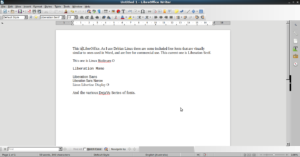 Click on the image to see a bigger version. That said, the rest of this post will be behind a jump.
Click on the image to see a bigger version. That said, the rest of this post will be behind a jump.
The most basic concern would probably be the file formats and whether you can read .doc / .docx files from MS Word on LibreOffice. Short answer: Yes. You may get asked if you want to convert so that you can read it on LibreOffice – go ahead and do that if it happens (I’m afraid I haven’t read any .docx files in a long time). It’s simply to give permission for you to read the file in Write.
Write is also capable of saving to formats readable in MS Word/Office. Also, exporting to PDF. If exporting to PDF make sure you have all your formatting done in Write first, including any embedded images. LibreOffice write’s default format is .odt
Fonts are also of no worry; there are likely to be open-source versions of the most common ones, as per the sample text I typed up, and a few more examples in the image from the drop-down box below. LibreOffice also is capable of reading any fonts installed in your font folder and can be used as you wish.
The Edit function has the following familiar tools:
As do the other functions. (click on the images to see better.)
As
I usually use Insert: Page break to ensure that the next chapter will be on a new page and not end up being on the same page as a chapter ending.
Insert: Comment is really, really useful when you’re doing editing. You can highlight the text with highlighter and write your comment in a comment box. I’m afraid I haven’t really tried to use this much – my editor does, however, and it’s SUPER HELPFUL. I imagine this would also be useful for alpha reader reactions and beta reader notes as well!
I suppose there is a way to edit the author of the comment and the highlighted colours changed, but I have not tried this out. If you have, please comment! I’m sure it’ll be useful to someone reading this post!
Styles has the stuff I used the most in order to set up chapters for print and ebook formatting. The POD service I use, Lulu, has free downloadable templates that I copy the manuscript text into later and then format as necessary. As there are other services that use .pdf, I format as I need then export to .pdf. You may need to consult your print/ebook service for their preferred formatting guides. To export to .epub, I’ve used Calibre, which is something I usually use to read ebooks on when I want to read them on my Linux box. (Especially handy, when you want to read books from Gutenberg.org …)
The dictionaries and thesauruses, I imagine, can be downloaded and installed; and you can also add your own words as necessary.
View seems to handle your toolbars and such. I have demonstrated how the window changes if you toggle on View: Styles and Formatting below.
Updated on Feb 12, 2018:
LibreOffice supports export directly to epub as well as PDF.
Finishing this off with a TL:DR summary:
- LibreOffice can be used across Windows, Macs and Linux OSes.
- LibreOffice Write has a very similar look and performance to MS Word.
- Has the ability to save to multiple common formats, as well as export to PDF (and now, epub ebook format as well).
- Very low learning curve, in my opinion
- Useful for writers and potentially for getting feedback from multiple alpha/beta readers
- Free, Open Source program (originally a fork of Open Office, but now stands solidly on it’s own.)
I’m sure this may be woefully inadequate as a post but as I noted before, this was meant to simply give folks curious about it a quick look at the program via screenshots and some small commentary from a pretty basic user’s point of view. So I hope that this post is useful for writers and other folks curious about using LibreOffice, especially LibreOffice Write.
My children use LibreOffice for school purposes with no issues, so if you’re a parent perhaps that tidbit will help as well. ^_^

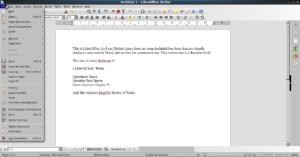
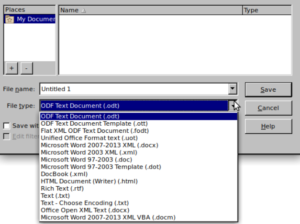
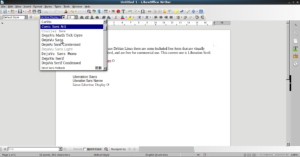
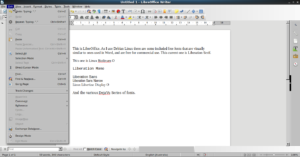
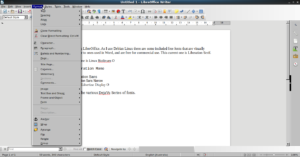
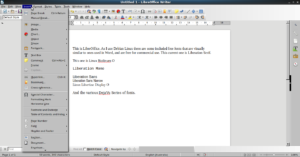
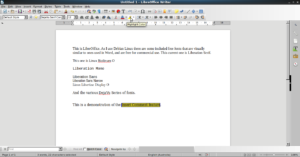
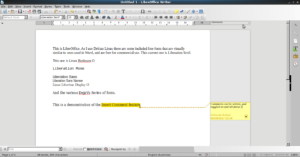

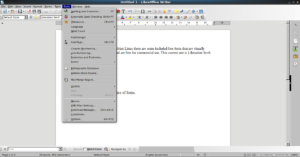
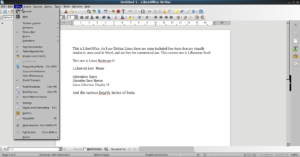
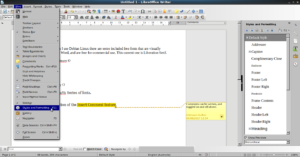
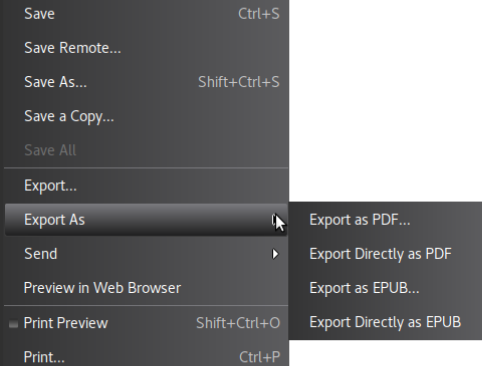
Do you have any views on Libre vs Apache?
Once upon a time, there was StarDivision StarOffice, a little office suite made by a German company from 1985 through to 1999. They got bought out by Sun Microsystems. In 2000, Sun decided to make the source code of StarOffice available as a free and open alternative to Microsoft Office; and thus OpenOffice.org was born, saving us from not having an alternative option when some douchebag soon-to-be-not-friend would curse us by sending another bloody .doc file.
OpenOffice spread pretty quickly – it was fantastic for the time, and development seemed to be quick. Then, along with a lot of other good things in life along came Oracle Corporation and bought it in 2010.
They renamed it to Oracle OpenOffice and reduced the assigned development staff, introduced a number of weird policies and stopped accepting patches/contributions from people other than IBM and a few other choice corporate entities.
At this point, most of the people who worked on OpenOffice from the FOSS side of things bailed and formed The Document Foundation. They forked the project code and created LibreOffice. Within a very short period of time due to general distrust of Oracle (which was justified based on previous actions by Oracle, and their next actions) almost all major Linux distributions switched to LibreOffice. This is important because in cases like this the people using Linux distributions are the people who submit patches because they go ‘hey, I want this feature… I’ll add it’ – and thus the whole ‘oh that’s a big deal’ comes into play.
In 2011 (I forget which month) Oracle stopped developing OpenOffice.org and fired the remaining StarOffice team. At this point they should have given the OpenOffice name to The Document Foundation, but to be douche bags to the end they gave it to the Apache Software Foundation.
Note that I don’t have anything against the Apache Software Foundation, or variety/alternative things in general. Variety is good. Variety is what allows Debian GNU/Linux to exist when there are many other distributions to choose from. However, when it comes to something as complex and standardised as an office suite in order for there to be variety there needs to be significant developer effort or collaboration on all sides. That isn’t currently happening, from what I can see. All major development effort very quickly ended up in the LibreOffice camp.
LibreOffice development massively and rapidly outpaced OpenOffice development from this point. LibreOffice is a monumental step ahead in terms of features and speed. You can confidently open a Microsoft Office document in LibreOffice and it will ‘just work’ without issues that OpenOffice regularly encounters (as of the versions available August 10, I checked just before posting this to be sure).
Oracle was looking to close off the FOSS valve and start monetising everything, and the community gave them a big middle finger and moved on with libre and life. Oracle have screwed over more than just GNU/Linux and BSD users though; any Mac or Windows users relying on MySQL, or anyone hosting a web site might notice that Oracle MySQL sucks now (surprise, another project that they obtained after buying Sun) and some hosts may encourage you to use MariaDB instead – or worse still, OracleDB.
Want more on this? https://wikileaks.org/plusd/cables/09BRUSSELS1455_a.html
SHORT VERSION:
You can upload a document from LibreOffice and have it work immediately with iBooks, Amazon, Lulu, etc. You cannot (as of 10th August 2017) do this in OpenOffice without some (admittedly minor) issues.
You can open a document from Office 365 in LibreOffice and have it work immediately (with at most, very minor formatting issues that can be corrected in a few minutes). You cannot (as of 10th August 2017) do this in OpenOffice without some (somewhat major) issues on some documents.
The reason I cite the above? Despite using a Linux distribution, I still receive a lot of documents from people using Microsoft software. I need to be able to open it reliably and have it display correctly. LibreOffice will do this, OpenOffice may not.
If you are considering switching to a FOSS office suite, make it LibreOffice. The experience you have with OO is likely to be… bad.
Note: This isn’t meant to say anything bad about the Apache OpenOffice developers in any way. They are very talented, but they are seriously understaffed. There appear to simply be insufficient resources to maintain the project.
Huh. I guess I was using OO then for a while and didn’t know it.
From the quick search I did, they were hosted at Open Office for a while and then split; part of why I asked, since Apache is currently there.
I THINK that I ran into Kingsoft there, too, but danged if I know. It may have just been the least annoying result that came up when I looked for “open office.”
Apache OpenOffice – despite what I’ve said – is at least not malicious. It’s just underdeveloped and behind the times.
Kingsoft on the other hand use aggressive keyword/marketing techniques to get onto as many systems as possible. You likely wouldn’t have found their software on the OO.org web site, but you probably would have found it associated with everything via a search engine.
I would not consider them a legitimate software provider.
My sub-reason for asking– my mom can’t use the new Windows 365 because it’s just too different from what she’s use to, so I put Kingsoft on her PC.
They now have annoying popups that mess with her, plus they’re Chinese which worries my husband.
I’ve got Apache on my newly reformatted PC, and now have Libre on my laptop, but it’s much better to just ASK rather than pray I’ll run into any issues. 😀
I’d definitely suggest getting rid of Kingsoft Office.
If downloading LibreOffice btw, make sure to select from the drop-down options to grab the Windows x64 version if you are using a 64-bit version of Windows.
Did. 😀
My dear hubby’s rantings HAVE soaked in a LITTLE.
Main reason I’m not TOO worried about what my mom’s using– if China really, really cares about the ancestry for 300 head of cattle in central Washington, they have serious issues and I am more than willing to waste their time.
Some of the malware from Chinese criminal organisations is designed to perform the following things in the following order of priority:
There are ‘clean’ versions of Kingsoft Office, I would take the minute required to verify if you have one of those if you intend to leave it on the system.
While ‘not caring’ if the Chinese Government wishes to learn more about cattle populations is understandable, allowing it to cost you money is probably a less entertaining concept.
Her PC is thinks back I think ten years old, mostly from second-hand gaming rigs, but I’m definitely stealing from that to get her to not do the “I’ll just put up with it” thing.
Nothing wrong with a 10 year old PC, we have a few systems in that age bracket too… :p
The PC on which I game, I think, right? And maaaaybe my main rig?
I THINK mine is about seven years old, but the main thing is that it’s not mostly re-used.
grin I think the oldest PC we have that is still working though is that Amstrad. I love that thing. I think it really depends on how hard we are on the systems that determines how long they last.
Sophie & Hazel are both ten years old.
Claire is only seven.
The Amstrad is a 1986 machine. PC1512 classic, 8mhz 8086, 512kb ram, 20mb hdd, not-quite-CGA compatible, probably outlast every other workstation we have…
Is that the (in)famous “holy cow why does this even RUN?!?!” machine?
It’s one of these glorious machines:
https://en.wikipedia.org/wiki/PC1512
Despite its age, it is an x86 compatible unit. Files created or software used on a PC1512 can be used by a x86/64 computer in 2017.
Haven’t tried OpenOffice largely because once I made the switch I was happy with LO Write, as, for the most part until I had to start doing formatting for publishing, it got out of my way and let me write (and my issue was essentially having to dive off the deep end and finding out everything for myself regarding formatting, not the software.) I’ve had OO recommended to me a few times and when I mention using LibreOffice, which is really, a fork, the reaction I get is something along the line of ‘it’s a fork, OO will be so much better!’
Housemate, however, is of the opinion that LibreOffice is much, much better than OpenOffice in terms of FOSS, and considers it having better documentation and support than anything else out there. OO’s contentious history especially regarding the software publisher is probably one of the reasons why he’s so leery (I’d ask, but David’s asleep, and the only reason why I’m awake is so that I don’t wake Rhys because I got a sudden jag of grief out of nowhere. This is good distraction. As is looking up a pumpkin bread recipe. Actually, do you have an American style pumpkin bread recipe you could recommend?) I do remember him saying though that the majority, if not all of the original folks who worked on OpenOffice jumped to LibreOffice when the latter’s fork happened.
Oooh, I don’t have pumpkin BREAD, but I do have a pumpkin COOKIES recipe– Dana Pico’s Pumpkin Chocolate Chip Cookies. It’s made for using the big tins of canned pumpkin you get to make pies with, but any pureed (preferably baked first) squash will work– add spice to your taste, I like getting the mix that’s already got the pumpkin pie spices in it. (Nutmeg, cinnamon a bit of clove)
2 cups canned pumpkin
1 cup sugar
½ cup cooking oil
2 cups all-purpose flour
2 tsp baking powder
1 tsp cinnamon
½ tsp salt
1 tsp baking soda
1 tsp milk
2 tsp vanilla
1 bag Nestle’s Toll House chocolate chips
Preheat oven to 350º F. Combine pumpkin, sugar and oil in a mixing bowl. Add flour, baking powder cinnamon and salt, mixing well. Mix soda and milk in a separate container, then add to cookie mixture. Stir in chocolate chips and vanilla.
Drop by spoonfuls onto an ungreased cookie sheet, and bake @ 350º F until done; about 15 to 20 minutes.
Serve warm with lots and lots of ice-cold milk, and napkins, since you’ll get melted chocolate chips all over your fingers.
Derp. Replied to main post, not to you. Oops.
Emailed right to me anyways.
I’ve got a pumpkin, not very large, to make the puree out of; they don’t have the cans of pumpkin filling here, alas, so making pumpkin anything = making it totally from scratch, and I’ll probably have plenty extra; to make both cookies and bread with! I was thinking of steaming the pumpkin, but baking might be the second option in case it won’t fit in my steamer.
Today’s gotten really cold again; for about a couple of weeks we had almost spring weather temperatures. I guess Australia changed it’s mind again on what season it’ll be. sigh I suppose it’ll likely change again by midday.
Neat trick, you can substitute most winter squash for pumpkin with the right spices. ^.^
I thought of using kabocha but since I’m likely to be the one who is chopping the thing, I picked out some type of squash that looked like a pumpkin. Not as hard, iirc.
Oooh, that sounded familiar so I looked it up– you can bake those whole.
For a pumpkin pie sub, I’d actually cut them in half (along the equator), scoop out the seeds, put in brown sugar and whatever spices and THEN bake. Vegan sites says like 400 for 45-60 minutes.
The vegan sites claim that you can actually bake it whole with no sweetener at all and then cut it when it’s done… not sure how much I trust that. 😀
Baking without sweetener is what I did back in PH, but it was already a cut chunk of kabocha. It was easier to taste test after baking.
Typing with gloves. Cold for me…
sympathy
Rather, baking the piece of kabocha I used to make pumpkin bread without sweetener, and adding the sugar and spices later while mashing, is what I did. Bleh. Typing with gloves on sucked so I pulled off the gloves.
the problem I have with Libre Office is losing formatting. Probably doing something wrong, but I haven’t figured out what.
Would need more information to help with that.
Are you having trouble with formatting from documents opened in another format, e.g. from Microsoft Office? Or are you having formatting issues when saving documents between formats?
If you are saving documents with LibreOffice for use in LibreOffice or most other office suites, use the default Open Document Format (ODF) which is an .odt file.
If you are opening/saving documents within LibreOffice that originated from Microsoft Office, you should use the same file format they originated in. LibreOffice should warn you about this.
It opens and shuts in RTF but keeps on altering whether paragraphs stay together and the like.
Rich Text Format (RTF) doesn’t really support a lot of formatting in its actual, proper standard. It’s possible when you are saving the document, LO is removing all formatting that isn’t officially part of the RTF standard.
If you save the document in another format (such as ODT) as a test, does it work?